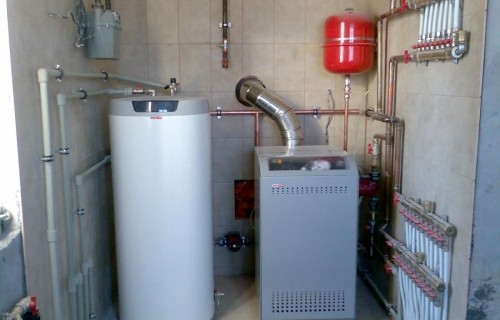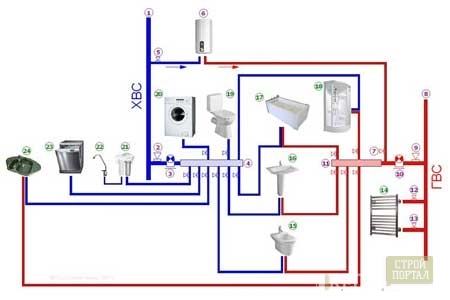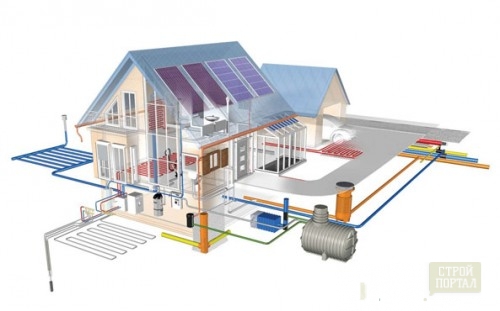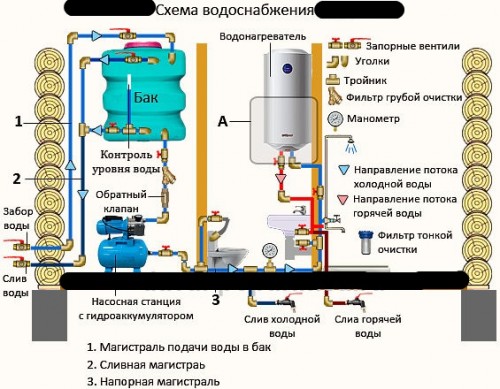
Hot water supply of a private house. Device, Installation, Methods for implementation Plumbing

Installation of a hot water supply system is an important and responsible work. In this article we will try to understand the features of hot water supply of private houses, consider alternative sources of hot water supply and learn how to mount the system yourself.
Content
Beginning of work. Preparatory stage
Calculation of hot water supply it can be done in the finished house, but better, at the design stage of the construction, to place water supply devices in an optimal way. Followed by:
- Select the water supply source into the house (central highway, well or well).
- Select location of water heaters, drives and other equipment. Sometimes the boiler room is specifically built for this, which is placed either in the basement of the house, or in a separate room.
- Decide with the equipment.
- Directly connect hot water supply.
If the house is one-storey and warm water need only in the kitchen and in the bathroom, the type of water supply scheme will be one. Here heating is combined with heated water. How exactly, consider below.
As you can see, there is a small flowing water heater, which provides hot water all the necessary points in the house.
For a two-story mansion with a lot of bathrooms, it is better to elect another hot water system.
Here it is advisable to install more powerful devices and place them in the utility premises like underground boiler room.
Choosing a source of water supply to the house
It happens that in the private sectors there is no gas and sewage, but the water serves a centrally pumping station. In this case, the installation of hot water supply is reduced to the purchase of a small flow water heater or a double-circuit boiler, which will simultaneously give the house and serve hot water in the bathroom and in the kitchen. If in the village of water, everyone provides themselves, then here other requirements for hot water supply . A pump and a small well is useful right on the plot. Here it is advisable to divide the heating and water supply system to separate segments. As for the water specifically, it will additionally need a pump (submersible or superficial), water supply pump and preferably an additional emergency generator in case the electrician for some reason will disappear. By the way, this scheme will also allow, to install heating for the floor in the bathroom or children's.
Basic devices for feeding and heating water from well or well:
- Actually, well or well.
- Pump and pump for fence and water supply.
- Hydrogenator providing constant water pressure.
- Filters.
- Water heating equipment.
- The system of collectors with pumps, including fecal.
Directly heating water in the house
Now that there is already water in the house, choose exactly how this very water will be heated. It is worth considering that the installation of hot water supply is a rather time-consuming process and requires certain skills.
Read more about this in video:
Water heaters are offered to the buyer:
- Single-mounted boilers that directly heat the water in the house. Operate from a power out or gas. Need a boiler installation additionally.
- Double-circuit boilers. One contour in them works exclusively as a heating device, and the other - as a flowing water heater.
- Electric water heaters of accumulative type. There are small (volume of heated liquid 5-10 liters), medium (about 50-100 liters) and large (1000 or more liters of heated water).
- Flowing water heaters (gas or electric) that are suitable for large mansions with two or more floors. There are: gas columns, the contour of the two-kilt, the flowing water heater is electric.
Pros and cons of each of the GWS systems
All of the hot water supply systems listed above can be reduced to two main types of heaters: flow and accumulative. About them and talk.
Flowing heater
| pros | Minuses |
|
|
Cumulative water heater
The most popular is the usual electric boiler, which accumulates water and keeps its temperature for some time. They differ in the volume of the tank in which water accumulates and heats up:
- 5-10 liters, for example, wash hands after working in the garden;
- 50-100 liters (wash the dishes, take a shower);
- From 1000 liters - for the needs of a large family.
Another type is a gas cumulative water heater. But it does not cause special interest among buyers, therefore it is found quite rarely.
The third type of such heaters is a boiler with indirect heating. It differs from others this unit in that, thanks to the built-in heat exchanger, it accumulates and heats the fluid using the heating coolant in the house. And, it means that such a boiler will be particularly beneficial in the winter, because additional resources for heating water will not be required.
| pros | Minuses |
|
1. The amount of warm water is limited to the boiler tank. 2. The process of heating a cold liquid occupies a fairly long time. 3. Bulk burrows, occupy a lot of space and often require a separate room (boiler room). |
Organization of hot water supply
It is important to remember that it is impossible to mount the pipeline on the principle of cold water supply, since it is dead-end and ends at the point of water intake. If you use this scheme, the water will just cool in the pipes. The hot water pipeline must be flakes:
Heating - Feeding to the place of water intake - Return to the heating element
Such a scheme is optimal for sections with a separate boiler room, where the device of hot water is more complicated than in homes with a conventional flow water heater.
The following scheme shows the principle of mounting hot water supply in a small private house. Its main feature is the replacement of the pressure tank to the ordinary boiler with a volume of 500 liters. In addition to this, you can place a boiler in the attic, but it involves the cost of additional insulation of the unit.
And finally, you need to choose pipes and suitable fittings. For water supply in a private house, pipes of diameters of 15 or 20 inches made of steel (galvanized or not galvanized), polypropylene and others are used. At the same time, the most popular metal-plastic pipes today. The main advantage of these pipes is simplicity of installation. They do not need welding - only press fittings and a small snack. In addition, they are hardy: working temperature +95 degrees. Another important fact in favor of such pipes is a high level of protection against oxygen penetration. And, it means that it is possible to avoid importance, oxidation and rapid damage of the entire water supply system or heating.
If the choice is still fell on polypropylene pipes, it can be soldered with:
- scissors;
- soldering iron for PPR pipes (nozzle diameter 2 cm);
- fittings to the pipes;
- roulettes and markers;
Now the case of technology:
- Measure the necessary segment of the pipe (with a mandatory reserve of 1 cm for the entrance to the fitting).
- Exactly by the label cut off the pipe and check it for a blockage.
- We insert the fitting and the pipe into the soldering iron, heating no more than 10 seconds.
- We insert the heated tube into the fitting, hold the items about 4 minutes for high-quality soldering.
- Enjoy the design and again check for the permeability and lack of blockages.
How to mount the plumbing with your own hands here:





















